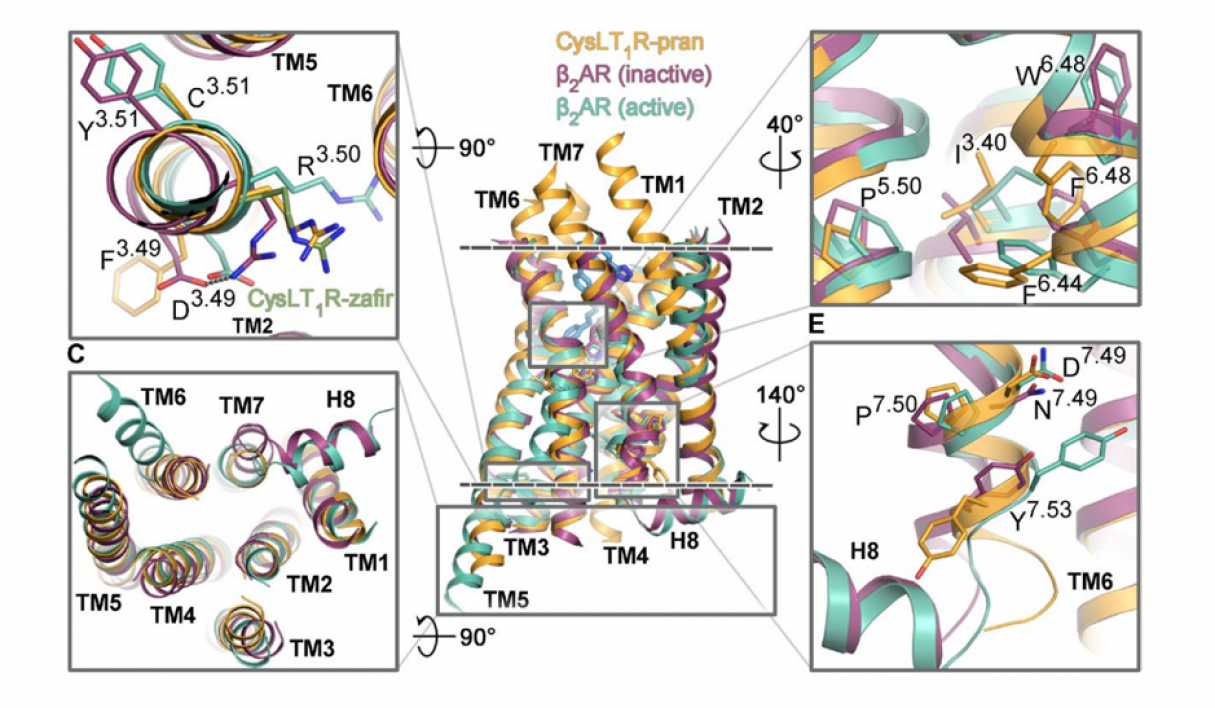Combining forces: Biophysicists study molecular effects of asthma drugs

In the paper, the researchers investigated the structure of a G protein-coupled receptor known as CysLT1. It is involved in inflammatory processes and plays an important role in allergic diseases, including asthma, which affects about 10% of the global population.
A research team from the MIPT Center for Molecular Mechanisms of Aging and Age-Related Diseases collaborated with colleagues from the U.S., Canada, France and Germany to determine the spatial structure of the CysLT1 receptor in a paper published in Science Advances (DOI: 10.1126/sciadv.aax2518).
Amongst these collaborators were three researchers from Arizona State University’s Biodesign Center for Applied Structural Discovery: Wei Liu, also an assistant professor in the School of Molecular Sciences; Uwe Weierstall, also a research professor for ASU’s Department of Physics; and Hao Hu.
In the paper, the researchers investigated the structure of a G protein-coupled receptor known as CysLT1. It is involved in inflammatory processes and plays an important role in allergic diseases, including asthma, which affects about 10% of the global population. The team of biophysicists obtained the detailed 3D structure of the receptor with zafirlukast and pranlukast, which are two drugs prescribed to patients with asthma, allergic rhinitis and urticaria.
“By solving the 3D structures of the cysteinyl leukotriene receptor, we can better understand the unique structural details of this important drug target,” Liu said. “Armed with this knowledge, it becomes easier to design lead compounds that will minimize unwanted side effects.”
G protein-coupled receptors, or GPCRs, are molecular machines incorporated into cell membranes. These receptors pick up specific signals on the outside of the cell and transmit them to the interior of the cell. The signals come from various sources, including photons of light, fat molecules, small proteins and DNA fragments. A GPCR can trigger various events in the cell, including division, relocation or even death.
The GPCR-mediated cellular “communication” is crucial for the functioning of an organism. It’s no wonder that these receptors are in some way involved in all processes in our bodies. They are the targets of about 40% of existing medications as well. Thus, it is interesting for structural biologists to understand the functioning mechanism of these biological machines and find ways to control them by developing new drugs.
Structural biology is a cross-disciplinary field at the interface of physics and biology, concerned with studying the 3D arrangement of biological macromolecules, such as proteins. Structural studies involve genetic engineering, artificial protein production, purification and crystallization. Once the protein crystal has been obtained, the physics comes in. Researchers expose the protein crystal to powerful X-rays to generate diffraction patterns. The resulting data can be mathematically processed to recover a detailed 3D atomic structure of a given protein molecule, with a precision of up to several angstroms.
Structural studies rely on powerful X-ray sources, which include synchrotrons and the more recently developed free electron lasers. In both cases, electrons are accelerated to nearly the speed of light. They are then forced to change their speed or direction, leading to X-ray emission. In a synchrotron, the electrons move along a curved, almost circular trajectory. In a free electron laser, they travel through a passage between two rows of alternating oppositely directed magnets, known as an undulator.
While structural biologists have used synchrotrons since the 1970s, free electron lasers are a relatively recent addition to the protein crystallography tool kit. Introduced in the early 2010s, they generate extremely powerful radiation and enable X-ray diffraction analysis of minuscule 1-micrometer crystals. This new instrument has already brought about the discovery of several hundred structures.
While relatively large, 0.3-millimeter crystals with pranlukast were grown in the study, the crystals with zafirlukast only reached the size of several micrometers. The former samples were investigated at the ESRF synchrotron in Grenoble, France. The latter were examined using the Stanford University-operated Linac Coherent Light Source, a free electron laser. The researchers’ colleagues from Canada helped to explore the mechanisms of signal transmission via CysLT1.
“These are no doubt unique structures, and we’ve grown quite fond of them,” said study co-author Aleksandra Luginina from the MIPT Laboratory of Structural Biology of G Protein-Coupled Receptors. “The CysLT1 receptor’s mechanism of operation updates how we see the functioning of GPCR protein subgroups. Also, by identifying the binding sites for the zafirlukast and pranlukast molecules, we lay the basis for improving asthma medications — increasing their efficiency and reducing side effects.”
GPCRs are notoriously difficult objects for structural studies. Only a handful of labs worldwide have managed to complete research projects of this kind.
Written by MIPT
More Science and technology

ASU postdoctoral researcher leads initiative to support graduate student mental health
Olivia Davis had firsthand experience with anxiety and OCD before she entered grad school. Then, during the pandemic and as a…

ASU graduate student researching interplay between family dynamics, ADHD
The symptoms of attention deficit hyperactivity disorder (ADHD) — which include daydreaming, making careless mistakes or taking…

Will this antibiotic work? ASU scientists develop rapid bacterial tests
Bacteria multiply at an astonishing rate, sometimes doubling in number in under four minutes. Imagine a doctor faced with a…


